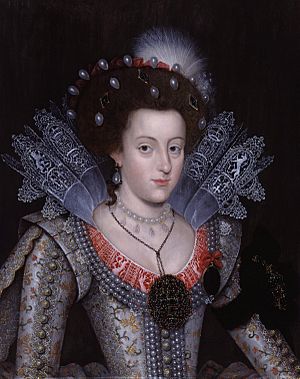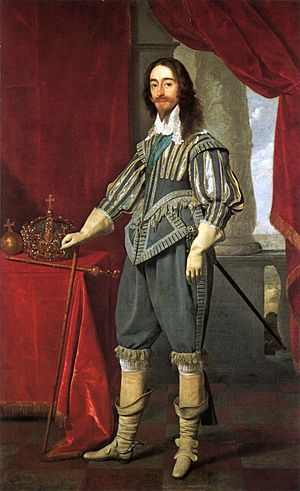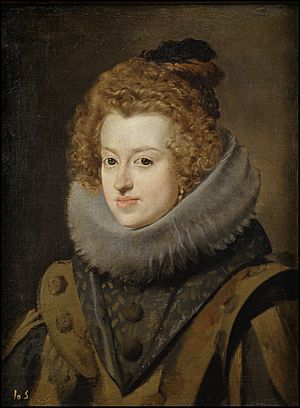Spanish match facts for kids
The Spanish Match was a plan for Prince Charles to marry Infanta Maria Anna of Spain. Prince Charles was the son of King James I of England. Maria Anna was the daughter of Philip III of Spain.
This marriage idea was discussed from 1614 to 1623. It became a big part of England's foreign policy and religious discussions. In the end, the marriage never happened.
Many people in England, especially Protestants, did not like this idea. They remembered the recent war with Spain. The Spanish ambassador, Gondomar, came to London in 1614. He offered that Spain would not bother James I's rule in Ireland. In return, James would stop English "privateers" (pirates) in Spanish American waters.
Gondomar also suggested the marriage. He offered a large sum of money, a dowry of £500,000. This was very appealing to King James. He needed money after the Parliament of 1614 did not give him the funds he asked for.
The talks for this marriage lasted almost ten years. The main event happened in 1623 in Madrid. Prince Charles and King James's close friend, George Villiers, 1st Duke of Buckingham, traveled there. Even though a marriage contract was signed, the wedding never took place. People's strong opinions against it led to Parliament being closed down.
Contents
Why the Spanish Match?

A Spanish marriage had been suggested before for Charles's older brother, Henry Frederick, Prince of Wales. He died in 1612. Their mother, Anne of Denmark, liked the idea. After Henry's death, she supported a Spanish marriage for her daughter Elizabeth. But Elizabeth married a Protestant prince in 1613.
For Prince Charles, other marriage options were considered. These included princesses from Savoy and Tuscany, as well as Spain and France. Queen Anne supported a Spanish match at times until she died in 1619. She knew Spain was mostly looking out for its own interests.
People remembered past "Spanish matches" that had not gone well. For example, Catherine of Aragon came to England, and Philip II of Spain married Queen Mary. These marriages were not popular in English history.
King James I's Plans
In 1618, King James I was in a good position with other countries. He had worked hard to prevent wars in Europe. He was a Protestant ruler who got along with Catholic countries. But his success began to fade as the Spanish Match failed. This also happened as the Thirty Years' War began.
King James wanted to improve his relationship with Spain. He even had Sir Walter Raleigh executed. Raleigh was a famous explorer who had attacked Spanish ships.
At home, King James needed money. A dowry from a Spanish marriage for Prince Charles could help him. This would mean he would not have to ask Parliament for money. The idea of the Spanish Match was supported by some ministers who liked Catholics. They were called the "Spanish Party." But many Protestant groups in England did not trust this plan.
In 1621, James called Parliament to get money. He wanted to help his son-in-law, Frederick V, Elector Palatine. Frederick was married to James's daughter Elizabeth. Parliament did not like the Spanish Match.
The Pope at the time, Pope Paul V, would not allow a Catholic princess to marry a Protestant. The Spanish king knew this, but the ambassador Gondomar did not seem to know. Pope Paul V died in 1621. The new Pope, Pope Gregory XV, seemed more open to the idea. King James sent a diplomat to Rome to argue for English Catholics. The Pope's advisors said that English Catholics needed to be treated better first.
Political Disagreement
By the 1620s, people in England felt very strongly against Catholics. A war had started in Europe, the Thirty Years' War. This war was between Catholic and Protestant groups. The people of Bohemia chose James's son-in-law, Frederick V, as their king. This angered the Catholic Holy Roman Emperor. Frederick was later forced out of Prague in 1620.
James had to call Parliament to get money to help his daughter Elizabeth and Frederick. Parliament gave him some money, but not enough for a big war. They also wanted a war directly against Spain.
In November 1621, Parliament, led by Sir Edward Coke, asked James to stop the Spanish marriage. They wanted Prince Charles to marry a Protestant. They also wanted James to enforce laws against Catholics. James was very angry. He told Parliament not to interfere with his royal prerogative (his royal powers).
Parliament responded by saying they had rights, including freedom of speech. James wrote that he could not accept such "anti-monarchical words." With pressure from Buckingham and the Spanish ambassador, James tore their protest out of the record book. He then closed Parliament.
Public Opinion and Censorship
Outside of Parliament, many people were against Spain and Catholics. Pamphlets (small books) were written to attack the Spanish Match. These writings often used false information. Puritan groups especially published these attacks. Thomas Scott was famous for his writings against the match starting in 1619.
King James tried to stop people from writing or speaking about state matters. He issued decrees in 1620 and 1621. John Everard preached against the match in 1621. He was put in prison for about six months. People had to be careful when talking about the match.
Thomas Middleton's play A Game at Chess in 1624 showed the events of the Spanish Match. It was very critical of Gondomar. The play was a huge, but short-lived, success. It was unusual for a play to show members of the royal family in such a way.
Charles's Trip to Spain

King James had no military option to help his daughter. So, he went back to the Spanish Match plan. He hoped it would help get Elizabeth and Frederick's lands back. But the situation changed when Philip III of Spain died in 1621. His son, Philip IV of Spain, became king. The Spanish ambassador Gondomar lost some power to Olivares.
The marriage talks started to slow down. Prince Charles, who was 22, and Buckingham decided to go to Spain secretly. They hoped to win over the Infanta directly. They traveled under fake names, Thomas and John Smith. They arrived in Madrid on March 7, 1623. King Philip IV and the English Ambassador were very surprised.
Charles and Buckingham did not know two important things. First, Maria Anna really did not want to marry a non-Catholic. Second, the Spanish were delaying the talks on purpose. They never truly planned to agree to the marriage. They would only agree if James and Charles promised to get rid of the anti-Catholic laws in England.
They were welcomed at the Spanish court. Richard Wynn, a royal attendant, joined the Prince in Spain. He wrote about the Spanish people and the journey.
Francis Stuart brought jewels for Prince Charles. Many of these jewels had belonged to Anne of Denmark, Charles's mother. These included a jeweled sword, a large diamond, and a ring with a diamond frog.
Even though a secret agreement was signed, Charles and Buckingham returned to England in October without the Infanta. On their way back, they visited several Spanish cities and palaces. Many people in Britain were very happy that the marriage did not happen.
The Privy Council's Decision
From 1617, the Privy Council handled the marriage talks. This was a group of the King's closest advisors. They had a special group to deal with Spain secretly. In January 1624, the Privy Council voted to reject Spain's terms for the marriage. This was the final decision.
What Happened Next
Charles and Buckingham were upset by how they were treated in Spain. They changed King James's plan. They now wanted Charles to marry a French princess. They also wanted a war against the Spanish Empire. To get money for a war, they convinced James to call Parliament again in February 1624.
This time, the court also showed strong anti-Catholic feelings. Charles and Buckingham now had more control over policy than James. They pushed the king to declare war. They even had the Lord Treasurer, Lionel Cranfield, 1st Earl of Middlesex, removed from his job and put in prison. He had opposed the war because of the cost.
Lord Bristol, the English Ambassador in Spain, was blamed for the marriage's failure. He was called back to England and later put in the Tower of London. Charles angered a very good public servant. They did not make up until the English Civil War started.
The Parliament of 1624 had mixed results. James still did not declare war. But Charles believed Parliament had promised to pay for a war against Spain. This belief caused problems for Charles with Parliament when he became king. Charles eventually married Henrietta Maria of France.
Gifts of Jewels
Prince Charles was given many jewels from the English royal collection to give as gifts in Spain. King James sent advice to his son about these gifts. When Charles said goodbye to the Spanish court, he gave many presents.
He gave the King of Spain a sword with diamonds. To the Queen, he gave two large diamonds and diamond earrings. The Infanta received a string of 250 pear-shaped pearls. Other gifts included a pointed diamond, a cross with diamonds, and many diamond rings and gold chains for various members of the court.
In Popular Stories
The visit of Prince Charles to Spain is part of the story in the novel El capitán Alatriste (1996) by Arturo Pérez-Reverte. It was also made into a film.
In 2011, a novel called The Spanish Match was released. It was based on these historical events.



